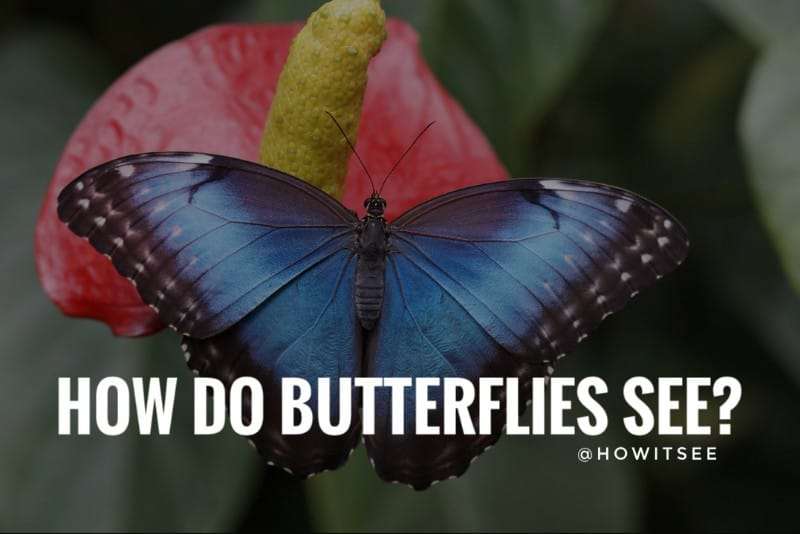Butterflies are beautiful insects from the large superfamily Papilionoidea that roams on Earth since 56 million years ago.
Everyone becomes happy after witnessing colorful butterflies wandering around the surrounding on different flowers. So, have you ever been fascinated by how butterflies see flowers or what colors butterflies see?
Butterflies see the world in millions of color shades comprising UV, violet, blue, green, and red, ranging from 300 nm to 700 nm. The color vision in butterflies depends on species to species. Most butterflies can perceive more colors than humans and glimpse the world with different imaginary color variations that are not visible to us.
For butterflies, vision is everything to carry out day-to-day activities like finding food, sensing flowers, and differentiating genders. Therefore, they need diverse kind of photoreceptors in their eyes that allows them to discern various colors.
Later in this post, we have explained much on “how do butterflies see the world,” along with other interesting facts. So, without any delay, let’s begin.
What colors do Butterflies see?
Most butterflies have six or more light-sensing cells: UV, violet, blue, green, red, and broadband. It allows them to see divergent colors of various wavelengths. Butterflies are considered to have the broadest visual range compared to any form of wildlife.
In contrast, a human eye has only three types of cells (blue, green, and red) that grant us trichromatic vision. Some butterfly species, like the common bluebottle butterfly, have 15 types of sensing cells in their eyes.
In this way, you can assume how much a colorful world a butterfly perceives with its eyes.
Note- The broadband cells respond to different wavelengths rather than a specific color.
Light travels in waves, and the distance between two waves is called wavelength. Hence, as illustrated in the image, different colors have different wavelengths.
An eye comprises photoreceptors in the form of rods and cones. Rods are susceptible to brightness and enable to witness the surrounding in dim light. In comparison, cones are responsible for the identification of distinct colors.
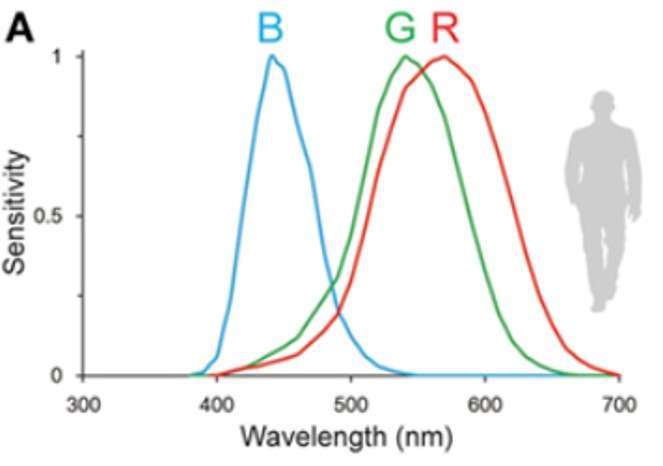
Image Source | kids.frontiersin
Many animals that are dichromatic in nature have the red cone missing. They glimpse the world in blue-green shades because their eyes are dominantly focused on rods (for night vision) rather than cones.
Also, some colorblind animals like dolphins and whales with one existing blue cone are said to be monochromats.
Humans with trichromatic vision typically have three types of cones: blue, green, and red, with maximum sensitivity at 420, 534, and 564 nm, respectively.
We can perceive colors of the small, medium, and large wavelengths and see the world in millions of color variations. The visible spectrum has a range from 380 to 720 nm. And before 380 nm, ultraviolet light comes, which is invisible to the human eye.
Also, as demonstrated in the image, our cones are least reactive at 380, 420, and 550 nm. It represents the color shades form at these wavelengths are minimally sensitive to the human eyes.
Explanation
In comparison, butterflies have complex color vision. Since the past, butterflies have been evolving their eyes by adding extra light-sensing cells with spectral sensitives.
Not only this, but they can also distinguish ultraviolet and polarised light. It assists them in finding a specific flower for food. However, butterflies’ eyesight is mainly dependent on their species.
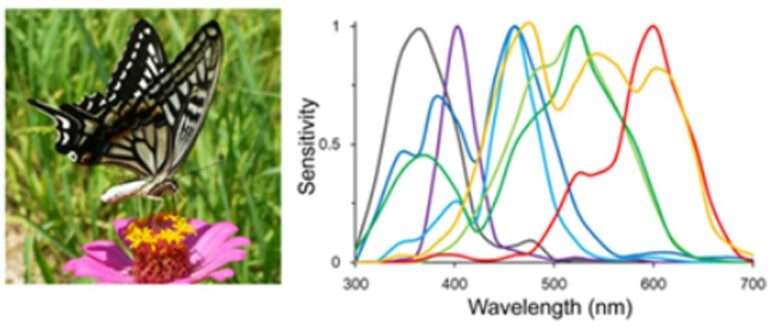
Image Source | kids.frontiersin
Above is the Japanese Yellow Swallowtail image with six types of light-sensing cells: Ultraviolet, violet, blue, green, red, and broadband (specific color of different wavelengths).
Through this colorful vision, butterflies see the world mostly in ultraviolet glow with different color variations. The combination of ultraviolet with different colors helps to recognize their partners, flowers, and external dangers.
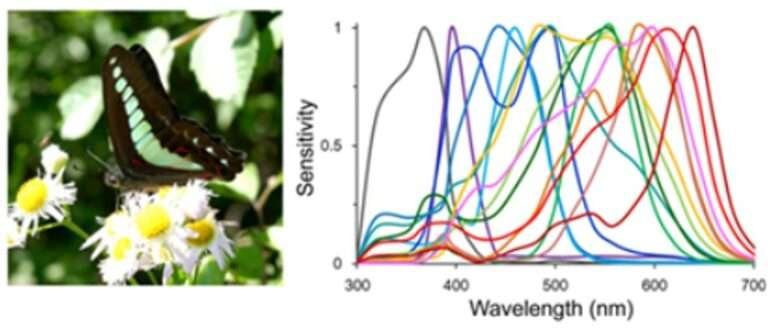
Image Source | kids.frontiersin
Not only this, the common bluebottle butterfly has fifteen kinds of light-sensing cells with spectral sensitivity curves.
In this way, you can imagine that the bluebottle butterfly glimpses the world and distinguish the various entities in a much brighter way than humans can only imagine.
Also, in the butterfly species, males and females have different color perceptions.
Do Butterflies have Good Eyesight?
No, butterflies have poor eyesight as compared to human vision. They do not have a clear vision and have a low-grade resolution; hence they are considered to be purblind due to lack of sharpness.
They can indeed sense the most comprehensive visual range of the spectrum. Even some species of butterflies, like a bluebottle, can perceive millions of color variations with their fifteen kinds of light-sensing cells.
They see the world in bright colors and ultraviolet light but with blurry vision. Below we have attached the image of how butterflies see the world.
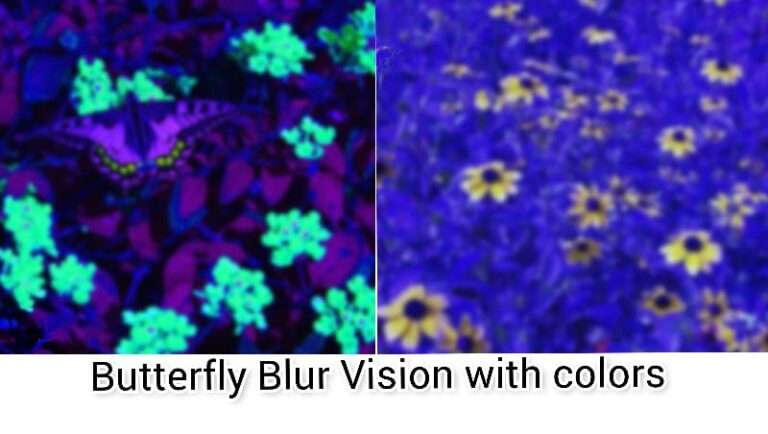
Butterflies see their surroundings predominately in ultraviolet lights. In this way, they distinguish them and flowers. Unlike humans, butterflies have different cones at maximum sensitives.
Butterflies are diurnal insects and have eyes primarily focused on cones. They can perceive different colors, fast-moving entities, and can discern UV and polarized light.
However, they cannot see objects in fine detail. Their resolution is approximately a hundred times worse than humans’ resolution.
In addition, butterflies can see 314 degrees of a wide range, but simultaneously, they have a minimum depth of vision. That’s is why they cannot see more than 100 feet.
In a nutshell, butterflies have dull vision with millions of color sensations, including UV and polarized lights. It helps them recognize their partners and identify the nectar of various flowers.
Can Butterflies see in the Dark?
Butterflies’ eyes are more focused on cones rather than rods; hence it is difficult for them to see in the dark. Butterflies are diurnal, which means they are active during the day, whereas at night, they become inactive and rest at some safe place.
Also, with the lack of sharpness, they do not even distinguish the shapes of the objects in dim light or cloudy weather. To navigate themselves, butterflies need a sufficient amount of light with colors.
Therefore, they are primarily active on bright sunny days. However, butterflies can still perceive ultraviolet light in the dark.
Can Butterflies see Humans?
Butterflies see humans like other large animals but cannot distinguish us. Their vision is not sharp, only dependent on the colors and near-sighted; therefore, it is impossible for them to differentiate between various animals and moving objects.
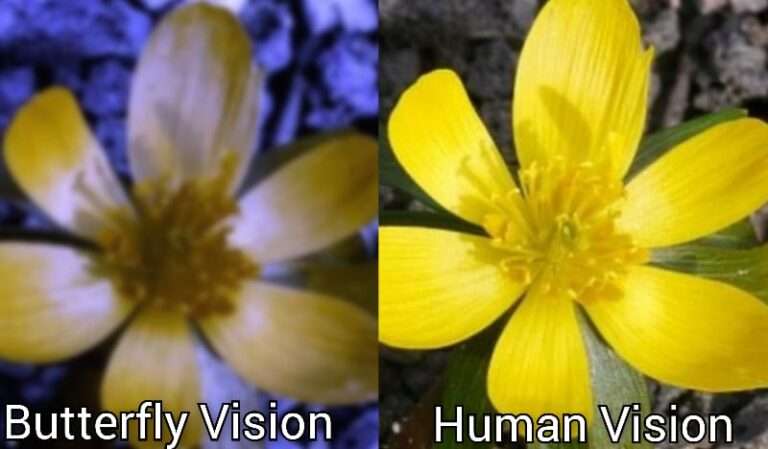
But they can easily identify the tiny insects, leaves, flowers, and other butterflies.
Butterfly vision vs Human vision
| Butterfly Vision | Human Vision |
| have five or more types of light-sensing cells that are UV, violet, blue, green, and red | have only three types of light-sensing cells that are blue, green, and red |
| Can differentiate between Ultraviolet and polarized lights | Cannot differentiate between Ultraviolet and polarized lights |
| have poor eyesight with low-grade resolution | have good eyesight with sharp resolution |
| Cannot perceive objects too far | Can perceive objects too far |
| See the world mostly in colors | See the world mostly in colors and details |
Here we conclude our article on “How do butterflies see or What colors do butterflies see,” along with other relevant queries. We hope you get your necessary information from here. We will be back with another post. Till then, stay tuned with us and read the articles after the FAQ section.
Frequently Asked Questions
Q1. How many colors can a butterfly see?
Ans. A butterfly can see millions of color shades forming with UV, violet, blue, green, red, and broadband.
Q2. What color attracts monarch butterflies?
Ans. Monarch butterflies are attracted to bright colors (orange, red, yellow, pink, purple) the most.
Q3. What colors to wear to attract butterflies?
Ans. Always wear bright color clothes to attract butterflies like orange, yellow, red, pink and many more.
Q4. Can Caterpillars see?
Ans. Caterpillars don’t have fully developed eyes. They have six small eyes called Ocelli that detect only black and white colors.
Q5. How far can butterflies see?
Ans. Like other flying insects, butterflies can see up to 100 feet.
Symbols
nm- namometer
1 nm = 10–9 meter
References
Image Source | kids.frontiers, MorgansLists
What Butterflies See: by MorgansLists
The More, the Better? by kids.frontiers
Are Butterflies legally blind? by askbiologist
Also Read:

Meet Abhidept (nickname Monty), the visionary founder of How It See, being an engineering student, he’s fueled by an insatiable curiosity about the world around him. He is captivated by an eclectic correlation between animal groups, science, and nature, and this fascination drives his quest for understanding.
After completing his degree, he’s set on a mission to delve deep into the realm of nature, accumulating knowledge to share with you through his writing. In the meantime, he loves to watch anime and read anime.
